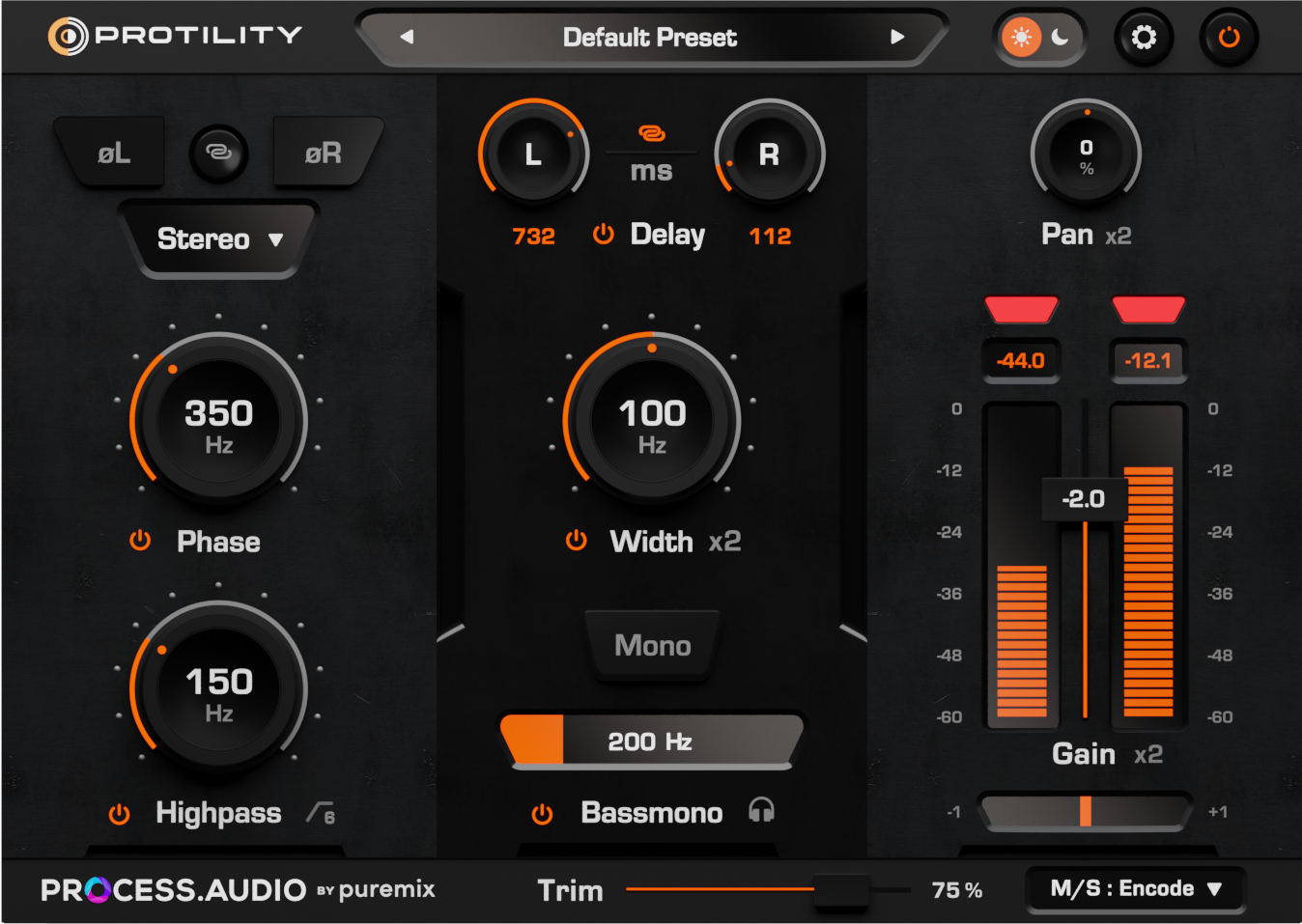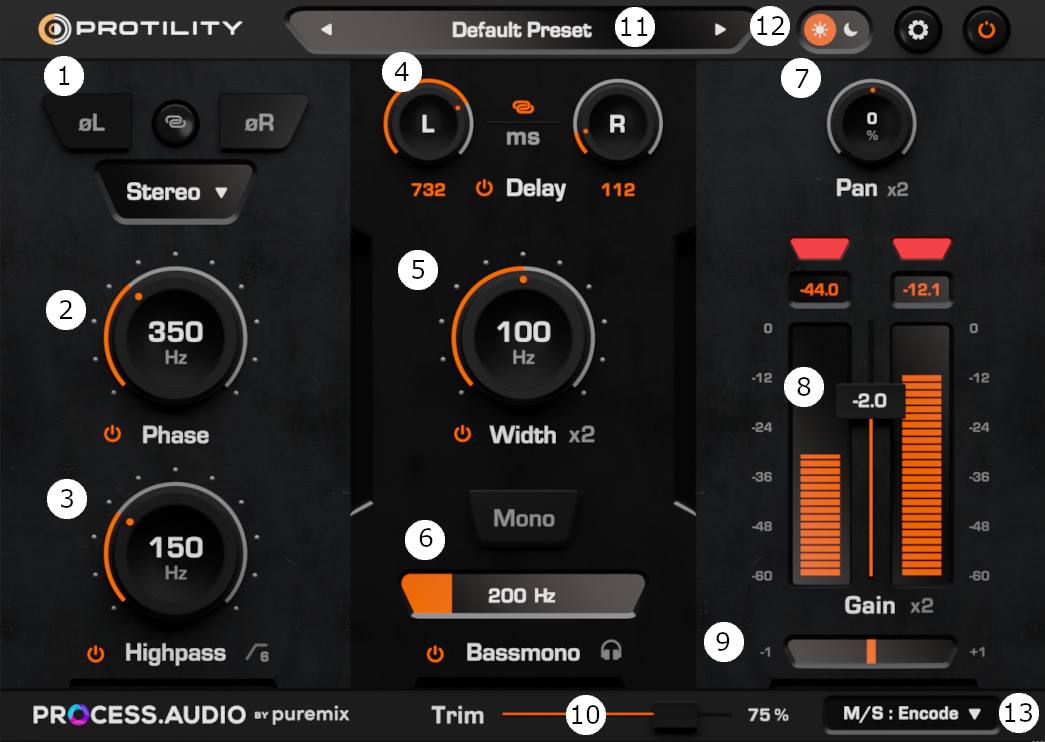
USER MANUAL
version 1.1.0
Introduction
About PROCESS.AUDIO
Making records used to be about the music. In the recent past, with the advent of the digital workflow, making records has increasingly become an exercise in minutia as well as a plugin arms race, creating a steep learning curve and shifting focus to the tools at the expense of the music. PROCESS.AUDIO was founded by a team of world-class music-making professionals, led by Fab Dupont, to create music-making tools that strike the perfect balance between analog workflow and digital technology only enhancing their owner's process.
About Protility
Welcome to Protility, a free utility plugin compatible with all DAWs, with no license required.
It’s designed to help you quickly set up a track in preparation for your mix session, allowing you to adjust stereo width, phase, filters, and volume with ease.
Main Controls

1 - Phase Invert & Channel Selection
- Phase Invert Protility allows users to invert the phase of the left and/or right channel. The link icon enables simultaneous inversion of both channels for more effective A/B comparison.
- Channel Selection Protility lets users isolate the left or right channel of a stereo signal or swap the left and right channels.
2 - Phase
Protility features a phase shifter slider that allows you to adjust the phase of low frequencies. It utilizes a first-order all-pass filter, with the parameter controlling the cutoff frequency.
3 - Highpass
Protility includes a high-pass filter to remove low frequencies from your signal. The slope is set to 12 dB/oct by default but can be increased to 18 dB/oct by clicking the slope icon.
4 - Sample Delay
Protility includes a stereo sample delay, allowing you to delay the left and/or right channel by a few samples or milliseconds. The link icon lets you adjust both channels together or independently, making it easy to create effects such as the Haas effect.
5 - Width
Protility allows you to narrow or widen your signal by decreasing or increasing the side component of your signal.
- From 0% to 100%, the mid component remains unchanged, while the side component progressively increases from 0% to its full level. A width of 0% results in a mono signal.
- From 100% to 400%, the side component is amplified, creating the perception of a wider, larger sound.
- By clicking the x2 button, Mid and Side can be controlled independently. The Side slider has the same effect as the width slider. Whereas the Mid slider gives the possibility to boost or reduce (even cut) the mid part of the signal.
- Check point 13 for more on the Mid/side encoding.
6 - Mono & Bassmono
- Protility allows you to mono your signal with a simple click of the mono button.
- It also provides the option to mono only the low frequencies, adjustable from 10 Hz to 1 kHz, an essential feature for avoiding phase issues in the bass region.
7 - Pan
- Protility lets you adjust the pan setting of your signal, from full left to full right.
- By clicking the x2 button, you can adjust the pan of the left and right channels independently. This pro feature is useful for bringing an element to the center without affecting the other channel.
- In the settings, you can choose preferences for how the left and/or right channels are affected in volume when changing the pan value.
8 - Gain
This gain section displays Peak metrics, with a clipping LED for each channel.
The gain fader allows you to boost the gain up to +24 dB or lower it down to -60 dB, effectively cutting the sound completely.
9 - Correlation Meter
This correlation meter is useful because Protility works extensively with the phase and stereo image of your signal.
It provides an indication of your signal's mono compatibility and highlights potential phase issues.
- Close to +1: The left and right channels are in phase, indicating good mono compatibility. If it reaches +1, the left and right channels are identical.
- Close to 0: This indicates a very wide stereo image, with the left and right channels being significantly different. Mono compatibility should be checked.
- Close to -1: The left and right channels are in phase opposition. When summed to mono, this can cancel out most of the signal.
10 - Trim
Trim is a volume fader applied to the entire signal at the end of the processing chain. This approach to adjusting volume is useful for applying automation without altering the gain settings established during mixdown, for example.
11 - Presets
Protility comes with 19 presets and allows you to save your own, including setting a preferred default preset.
12 - Light and Dark Modes
Protility offers two display options: light and dark. Once selected, your choice will be applied and saved across all instances.
13 - Mid/Side encode, decode
Mid/Side (M/S) encoding is a mathematical transformation to convert a stereo left/right (L/R) signal into a Mid (center) / Side (stereo width) representation. This operation is reversible and allows separate access to the components shared by both channels (the center) and the elements that differ between the channels (the sides).
- Encode at the end of the processing, the signal will be encoded in a special way: the left channel will contain the mid part of the signal, while the right channel will contain the side part. Yes, the "sides" are a mono channel, but they create a stereo effect only when re-encoded with the mid signal.
- Mix Once encoded, you can apply effects separately to the mid or side signals, for example, by using dual-mono plugins or by routing these channels to separate mono tracks. Once you’re happy with the processing, it can be re-encoded by another instance of Protility.
- Decode will aggregate a mid/side encoded signal into a stereo track, as it should be heard.
- None is the default mode that preserves the signal as it is.